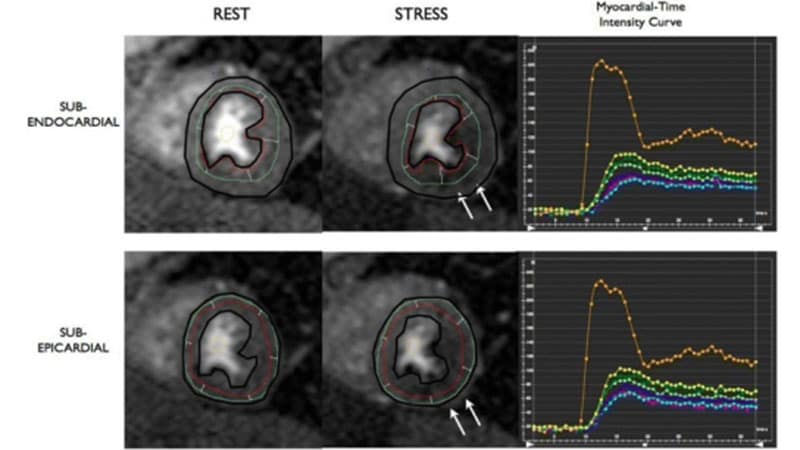Stress Cardiovascular MRI Accuracy in Chest Pain Assessment
Core Concepts
Stress cardiovascular MRI provides accurate diagnosis and risk stratification for patients with stable chest pain.
Abstract
TOPLINE:
Stress CMR offers high diagnostic accuracy and prognostic value.
METHODOLOGY:
Review of 64 studies with 74,470 patients.
Stress CMR vs ICA/FFR for diagnostic accuracy.
Reported data on all-cause death, CV death, and major adverse CV events.
TAKEAWAY:
3-T imaging enhances diagnostic accuracy.
Stress-inducible ischemia and late gadolinium enhancement linked to higher mortality.
Normal stress CMR results lower likelihood of CV events for over 3½ years.
IN PRACTICE:
Stress CMR accurately diagnoses and risk-stratifies patients with stable chest pain.
SOURCE:
Study by Fabrizio Ricci, MD, PhD, D'Annunzio University of Chieti-Pescara.
LIMITATIONS:
Did not compare stress CMR with other imaging modalities.
Mostly observational studies over two decades.
DISCLOSURES:
Supported by 2020 Search for Excellence Starting Grant.
Stress Cardiovascular MRI Accurate, Prognostic in Chest Pain
Stats
Stress CMR provides high diagnostic accuracy and adds prognostic value.
74,470 patients analyzed with a mean follow-up of 3.5 years.
Normal stress CMR results associated with lower likelihood of CV events.
Quotes
"Stress CMR yielded high diagnostic accuracy and accurate risk stratification."
"The assessment of inducible myocardial ischemia and LGE by stress CMR can accurately diagnose and risk-stratify patients."
Key Insights Distilled From
by Pauline Ande... at www.medscape.com 06-08-2023
https://www.medscape.com/viewarticle/992950
Deeper Inquiries
How has stress CMR evolved over the past two decades?
Stress CMR has evolved significantly over the past two decades in terms of technology, diagnostic accuracy, and prognostic value. Initially, stress CMR was primarily used for assessing myocardial perfusion and function. However, advancements in imaging techniques, such as the introduction of 3-T imaging, have improved the resolution and quality of images, leading to higher diagnostic accuracy. Additionally, the incorporation of late gadolinium enhancement (LGE) imaging has allowed for the detection of myocardial scar tissue, providing valuable information on the presence of underlying heart disease. Overall, these technological advancements have made stress CMR a more comprehensive and reliable tool for evaluating patients with chest pain and suspected coronary artery disease.
What are the potential drawbacks of relying solely on stress CMR for diagnosis and risk stratification?
While stress CMR offers high diagnostic accuracy and prognostic value, there are potential drawbacks to relying solely on this imaging modality for diagnosis and risk stratification. One limitation is the availability and accessibility of stress CMR, as not all healthcare facilities may have the necessary equipment or expertise to perform these specialized scans. Additionally, the cost of stress CMR may be prohibitive for some patients or healthcare systems, especially in resource-limited settings. Furthermore, stress CMR may not be suitable for all patients, such as those with certain contraindications to MRI or claustrophobia. Finally, the interpretation of stress CMR results requires specialized training and expertise, and misinterpretation of findings could lead to incorrect diagnoses or risk stratification.
How can advancements in stress CMR technology impact healthcare beyond cardiovascular assessment?
Advancements in stress CMR technology have the potential to impact healthcare beyond cardiovascular assessment in several ways. Firstly, the improved diagnostic accuracy and prognostic value of stress CMR can lead to more precise and timely diagnoses of cardiovascular conditions, allowing for earlier intervention and treatment. This can ultimately improve patient outcomes and reduce healthcare costs associated with managing advanced cardiovascular disease. Additionally, the non-invasive nature of stress CMR makes it a safer alternative to invasive procedures like coronary angiography, reducing the risks and complications associated with these interventions. Furthermore, the use of stress CMR for risk stratification can help identify high-risk patients who may benefit from more intensive monitoring or interventions, leading to more personalized and effective healthcare management strategies. Overall, advancements in stress CMR technology have the potential to enhance patient care, improve outcomes, and optimize healthcare resource utilization.
0
More on Healthcare
